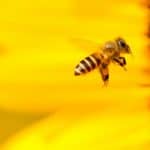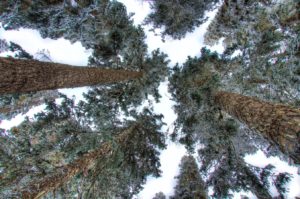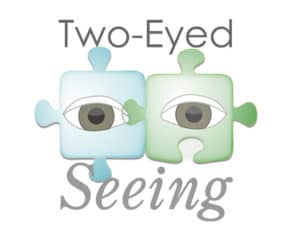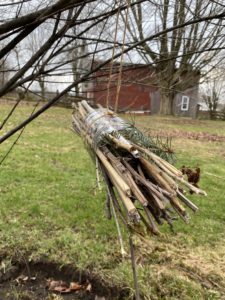Section Navigation
Introduction
Honeybees are important because they help our plants grow! Honeybees pollinate our fruits, vegetables and flowers. Did you know there are three types of honeybees? There are queen bees, worker bees & drone bees. Worker bees are the ones that do most of the pollinating. These bees help produce food for humans through pollination.
The transfer of pollen from one flower or plant to another is called pollination. Flowers and plants depend on pollination because without it they cannot grow and produce another flower or plant.
Honeybees are disappearing in some areas at a fast rate due to something called Colony Collapse Disorder (CCD). This disorder causes worker bees (the ones who pollinate our flowers, vegetables & fruit) to all disappear from a hive. Colony collapse disorder is well known in the bee community because it kills off a large number of honeybees. Many factors contribute to Colony collapse disorder such as viruses, mites, parasites and pesticides. Winter can also contribute to bee colonies dying but is not a contributor of CDD. In Canada our winters can be very cold. In Canada, on average about one in four bees die during the winter (Resource: CAPA Statement on Colony Losses).
Students will construct a bee hotel to help worker bees find a safe spot to rest during their busy days. Bee hotels can provide a safe spot for bees to take a break from flight, catch a quick snooze or meet up with friends along their journey to pollinate our flowers, fruits & vegetables! Not all bees pollinate flowers close to the beehive, therefore they can use these hotels as temporary homes. The bee hotels can hang outside around the school or be taken home to hang in their own backyards.
Fun Fact – Honey bees fly at a speed of around 25km per hour and beat their wings 200 times per second!
This lesson provides students with the opportunity to explore how we as humans directly impact wildlife and the environment. Students will be able to engage in a STEAM related activity that allows them to positively impact bees in their natural habitats. Students will examine the importance of bees in our society and the roles and responsibilities that they have.
Learning Goals
- Students will explore the use of recycled materials and natural materials found outside, to help worker bees rest during their long commutes by engineering a bee hotel.
- Students will explore ways in which society can positively impact bees and their natural habitats.
- Students will explore ways in which bees have an impact on society and the environment.
- Students will learn the importance of bees and how they help produce the food we eat.
Vocabulary
Habitat - A habitat is a home for an organism. A habitat provides all the essential needs for an organism to survive (i.e. plants need sunlight, water, nutrients and air to survive so they live outside in nature where they can access all those needs).
Organism - All living things or things that were once living (i.e. humans, animals, plants, insects).
Society - People who live in communities that come together as a whole.
Impact - When something or someone’s actions have a strong effect on someone or something, which can be positive or negative.
Pollination - The transfer of pollen from one flower or plant to another. Flowers and plants depend on pollination because without it they cannot grow and produce another flower or plant.
Queen Bees - A single queen rules each bee hive and provides roles and responsibilities to all other bees. Queen bees produce and lay eggs that will grow up to be the next generation of bees to live in the hive. Queen bees also produce a chemical that helps to guide the behaviours of all other bees in the hive.
Worker Bees - All worker bees are females bees. Their roles and responsibilities are to collect pollen and nectar from flowers, build the hive and protect the hive from any predators.
Drone Bees - All drone bees are male bees. Their roles and responsibilities are to mate with their queen bee and help produce the next generation of bees to live in the hive.
Engineer - A person who designs, creates and builds anything.
Responsibility - A task or behaviour that someone or something is expected to do as part of their role.
Colony Collapse Disorder (CCD) - A disorder that causes worker bees to all disappear from a hive.
Guiding Questions
- Who likes the following food items: apples, strawberries, honey and tomatoes? How do bees play a role in helping produce these food items?
- What is pollination and why is it important?
- How can we help bees survive and continue to pollinate flowers that turn into the foods we eat?
Curriculum Links
This activity connects the science and technology curriculum and relates it to society and the environment. This activity supports cross-curricular connections in science, geography, mathematics and social sciences. This activity allows students to explore how society and the environment positively or negatively impact one another. This activity encourages students in a responsible way to positively impact bees in their natural habitats and overall positively impact society by helping bees to produce the nutritious foods we eat.
Materials
Each student will need the following materials to create their bee hotel:
- Tree bark, pine cones, hollow reeds, bamboo stems or other natural materials that have fallen off trees/plants
- Small sticks & twigs
- Recycled newspaper
- Twine or string
- Large recycled plastic container (i.e. 2L pop bottle or yogurt tub)
- Scissors
- Tape
Non-Computer Activity
This activity omits technology from use to allow students to explore how they can help positively impact the environment that surrounds us and society as a whole, using simple materials. Students will use recycled materials and natural materials found outside, to create bee hotels that help worker bees rest during their long commutes. The steps below will help you guide students to build and create a bee hotel:
STEP 1: Have students collect sticks, twigs, pine cones, tree bark, hollow reeds, bamboo stems (or any other materials that you find outside), a large plastic container, twine or string, scissors, tape and newspaper.
STEP 2: Have students use scissors to cut the recycled plastic container to form a tube that will allow students to put their collected materials in both ends.
STEP 3: Have students roll a single sheet of newspaper at a time to form a tight tube. Have students tape the tube so that it keeps its shape. Next, have the students cut the tubes into smaller pieces that are about the same length as their sticks and twigs.
STEP 4: Have students use twine or string to keep the sticks, twigs, newspaper rolls and other natural materials together in a bundle. Have students lay down their piece of twine or string in a straight line and place the recycled materials and natural materials on top so that the string is center. Wrap the twine or string tight to create a bundle, then have them tie a knot to keep it together.
STEP 5: Have the students place the tied up sticks, twigs, newspaper rolls and other materials inside the plastic tube. If it is not a tight fit, have them add more materials around the inside of the plastic tube to avoid materials falling out.
STEP 6: Take the students outside into the schoolyard to hang their bee hotels in trees, or have them take them home to hang in their own backyard. Finally, have fun watching the bees visit the hotels!
Download Activity
Conclusion
Watch Storyline Online: Please Please the Bees written by Rashida Jones. See how the main character Benedict plans to also help the Honeybees!
Class Discussion Questions
- Why did Benedict decide to help the bees in his backyard?
- How did Benedict help the bees in his backyard?
- What are things that our society or community do that might negatively impact our bee population?
- What are ways in which our society or community can positively impact our bee population?
Additional Activity: Pollination Tag
Materials:
- Print attached PDF Fruit & Flower double-sided and cut in half
- Cotton balls
- Tape
- Large open area (gymnasium or outdoor field/yard)
Preparation Instructions:
- Provide each student with a copy of the Fruit & Flower sheet
- Allow students to colour in their activity sheet
- Provide students with a cotton ball and piece of tape
- Have students create a loop with their tape and then attach the cotton ball to the flower side of their activity sheet
- The cotton ball will represent the pollen in a flower
Game Rules:
- Select three students to be pollinators. The pollinators will chase after students that are holding flowers.
- When a student with a flower is tagged, they must give their pollen (cotton ball) to the pollinator. Then they may continue running away from the pollinators holding their flower.
- If the pollinator is already carrying a cotton ball, they can only tag a student who is carrying a flower without pollen. They must tag the student and hand the pollen to the student who was the flower, to pollinate it. When the flower receives pollen from the pollinator, they turn their flower over to reveal their fruit.
- Once a player turns into a fruit they will sit on the side as they no longer can offer pollen to the pollinators.
- Pollinators can continue tagging flowers once they get rid of their pollen.
- The game is over when all of the flowers have been pollinated and turned into fruits.
Resources
Share Your Work With Us! We want to see the awesome things you’re all creating with Pinnguaq. Share online with us and tag @pinnguaq on Facebook, Twitter or Instagram for your work to be featured. Don’t forget to include the hashtag #LearnWithPinnguaq! Keep tuning into Pinnguaq for more lesson and fun activities!




